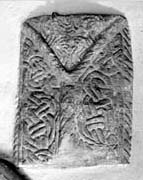Select a site alphabetically from the choices shown in the box below. Alternatively, browse sculptural examples using the Forward/Back buttons.
Chapters for this volume, along with copies of original in-text images, are available here.
Object type: Part of coped grave-cover
Measurements: L. 56 cm (22 in); W. 38 cm (15 in); D. 7.5 cm (3 in) but built in
Stone type: Pale yellow-brown (10YR 8/4) oolitic limestone, with ooliths of 0.4 to 0.6mm diameter and numerous shell fragments. As Cricklade 1, probably Taynton
Plate numbers in printed volume: Pl. 445
Corpus volume reference: Vol 7 p. 214-5
(There may be more views or larger images available for this item. Click on the thumbnail image to view.)
A (top): The edges, gable end and broad central rib are outlined with cable moulding. Within these divisions on the sides there is closely packed irregular interlace with doubled strands, with leaf-like terminals. On the gable end is an irregular branching motif in which the triple-stranded interlace forms undulating curves.
This is the only grave-cover of this form in the region (see introduction p. 32) and its crude, bold patterning sets it apart from the other Wessex coped grave-covers such as Bexhill 1 (Tweddle et al. 1995, 122–3, ills. 10–19). Its interlace may be based on a figure-of-eight pattern, but the loose terminals and the strange branching pattern on the gable is reminiscent of Anglo-Scandinavian art in the north-west (see Collingwood 1927, figs. 174 and 195). This piece therefore can be seen, in Collingwood's terms, as an example of the creeping influence of 'Anglo-Danish' survival (ibid., 183).



